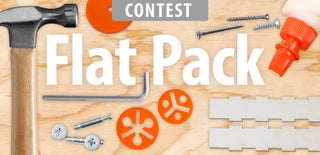Introduction: Bookshelf
This is a home made collapsible and expandable bookshelf.
Step 1: Materials
Materials needed to complete this project are as follows:
For the back
- 6 48" 1x2
- 2 24" 1x4
- 2 24" 1x2
For the sides
- 2 48" 1x4
- 2 48" 1x2
- 4 24" 1x2
For the shelves
- 2 24" 1x10
- 4 24" 1x8
3 8-ft L x 3/4-in W x 5/8-in H Aluminum Trim Channel
Tools
- Nail gun
- Nails for nail gun - 1 1/2" nails
- Wood glue
25-lb #8 x 1.625-in Bugle-Head Drywall Screw
- 4 Piano hinges
- 6 Cabinet hinges
- Clamps
- Screw gun
- Table saw
- Sander
- Planer
- Drill Press
(I bought all of these things at my local hardware store.)
Step 2: Building the Back
Take the 6 48" 1x2 and cut each to 40" boards.
Run each board through the planer.
Stack 3 of the 1x2 on top of each other to make a 3x2.
Place wood glue between each 1x2 and use clamps to hold in place.
Nail the boards in place to create one piece and to hold together while the glue dries. (I did this by gluing and nailing the first two and then adding on the third one.)
Repeat this with the other 3 48" 1x2.
Cut the 2 24" 1x4 into 12" boards.
Run each board through the planer.
Place one of the boards perpendicular to the top of the 3x2 and make sure the two pieces are flush.
Glue and nail the 1x4 into the bottom board of the 3x2. (I used a toe-nail shot.)
Repeat this process with the other 1x4 at the bottom of the 3x2.
Cut the 4 24" 1x2 into 12" boards.
Run each board through the planer.
Place one of the boards 9 1/2" from the bottom 1x4.
Glue and nail into place.
Place the other board 9 1/2" from the top 1x4.
Glue and nail into place.
Place the final 3x2 board perpendicular to the structure.
Glue and nail in place to make a mirror image.
Place one of the additional 1x2 on top of the upper 1x2 and nail into place.
Place the last 1x2 onto the top edge of the bottom 1x4 and nail into place.
Step 3: Building the Sides
Take the 2 48" 1x4 and cut into 38" boards.
Take the 2 48" 1x2 and cut into 40" boards.
Take the 4 24" 1x2 and cut into 8" boards. (You will need 8 of these 8" boards.)
Run each board through the planer.
Place one 1x4 board and one 40" 1x2 board parallel to each other and line up one of the ends.
Take 4 of the 8" 1x2 and place in 11" intervals between the boards, beginning at the bottom of the 1x4. (This should be on the end that the 1x4 and the 40" 1x2 are uneven.)
Glue and nail into place.
Repeat this for the second side.
Step 4: Attaching the Sides
Lay the back down flat with the back supports on the ground. (This is the back of the bookcase.)
Place the sides flat on the back to assure that they will fit and to find positioning for folded sides.
The sides should be flush with the top of the back and the extra portion of the 1x2 should be on the outside bottom to provide support when the bookcase is open. (The 1x4 is cut shorter to allow for easier swinging of the sides.)
Clamp the sides upright in their final positions.
Take the piano hinges and make the locations of the hinges with a pencil on the sides and back.
Double check that 2 hinges are on each side and that the sides will fold flat in those positions.
Screw the hinges on to the side pieces in the places marked.
Clamp the side pieces into place and screw the hinges into the back.
Step 5: Building the Shelves
Run the boards through the planer.
Cut 2 of the 1x8 boards so that they become 4 3/4" x 24" wide.
Glue and nail the boards onto the 1x10 boards to gain the extra width needed for the shelves.
Cut 2 of the 1x8 boards in half so that they become 12" wide.
Cut the Aluminum Channel into 11" strips.
Drill holes in the channel on each side big enough for your screws to go through.
On one side of the channel drill the two holes bigger to accommodate for the screwdriver bit.
On the other side of the channel drill one of the holes bigger on the inside of the channel to minimize the wood's contact with the screw head. (When doing this do four on one side and four on the other to accommodate for hold both sides of the inner board.)
Place four of the metal channels onto the top shelf 6 1/2" from the outer edge with the side for the screwdriver facing out.
Use screws to keep in place.
Place the other four channels 6 3/8" away from the other channel.
Screw into place.
Slide the bottom shelves into place.
Step 6: Attaching the Shelves
Place the two shelves onto the back of the bookcase to mark the location of the cabinet hinges. (The location should be on top of the two extra 1x2 on the back of the bookcase.)
Mark with a pencil the location of the holes.
Screw into place the hinges on the shelves.
Screw into place the hinges onto the bookcase.
Step 7: Finishing Touches
Clip the showing nail pieces with wire cutters.
Sand down any rough edges or splintering edges.
Stain the bookcase if you desire.

Participated in the
Flat Pack Contest











